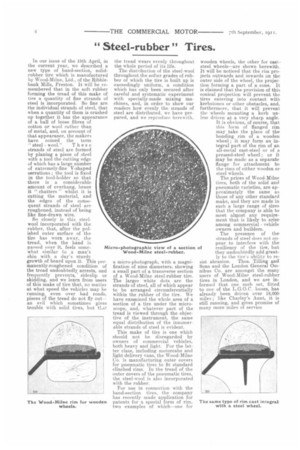" Steel-rubber " Tires.
Page 4

If you've noticed an error in this article please click here to report it so we can fix it.
In our issue of the 13th April, in the current year, we described a new type of band-section, solidrubber tire which is manufactured by Wood-Milne, Ltd., of the Ribblebank Mills, Preston. It will be remembered that in the soft rubber forming the tread of this make of tire a quantity of fine strands of steel is incorporated. So fine are the individual strands of steel, that when a quantity of them is crushed up together it has the appearance of a ball of loose fibres of cotton or wool rather than of metal, and, on account of that appearance, the makers have coined the term '` steel wool." These strands of steel are formed by planing a piece of steel with a tool the cutting edge of which has a large number of extremely-fine V-shaped serrations ; the tool is fixed in the tool-holder so that there is a considerable amount of overhang, hence it "chatters " whilst it is cutting the material, and the edges of the consequent strands of steel are roughened, instead of being like fine-drawn wire.
So closely is this steelwool incorporated with the rubber, that, after the polished outer surface of the tire has worn away, the tread, when the hand is passed over it, feels somewhat similar to a man's chin with a day's sturdy growth of beard upon it. This permanently-roughened condition of the tread undoubtedly. arrests, and frequently prevents, sideslip or skidding, and we learn from users of this make of tire that, no matter at what speed the vehicles may be running, even over bad roads, pieces of the tread do not fly out— an evil which sometimes gives trouble with solid tires, but that
the tread wears evenly throughout the whole period of its life.
The distribution of the steel-wool throughout the softer grades of rubber of which the tire is built up is exceedingly uniform, a condition which has only been secured after careful and systematic experiment with specially-made mixing machines, and, in order to show our readers how evenly the strands of steel are distributed, we have prepared, and we reproduce herewith, a micro-photograph, with a magnification of nine diameters, showing a small part of a transverse section of a Wood-Milne steel-rubber tire. The larger white dots are the strands of steel, all of which appear to be arranged circumferentially within the rubber of the tire. We have examined the whole area of a section of a tire under the microscope, and, whatever part of the tread is viewed through the objective of the instrument, the same equal distribution of the innumerable strands of steel is evident.
This make of tire is one which should not be disregarded by owners of commercial vehicles, both heavy and light. For the latter class, including motorcabs and light delivery vans, the Wood-Milne Co. is manufacturing outer covers for pneumatic tires to fit standard clinched rims. In the tread of the outer covers of the pneumatic tires, the steel-wool is also incorporated with the rubber.
For use in connection with the band-section tires, the company has recently made application for patents for a special form of rim, two examples of which—one for
wooden wheels, the other for caststeel wheels—are shown herewith. It will be noticed that the rim projects outwards and inwards on the outer side of the wheel, the projection forming a part of a cone. it is claimed that the provision of this conical projection will prevent the tires entering into contact with kerbstones or other obstacles, and, furthermore, that it will prevent the wheels mounting a kerb unless driven at a very sharp angle. It is obvious, of course, that this form of flanged rim may take the place of the bonding rim of a wooden wheel ; it may form an integral part of the rim of an all-metal cast-steel or of a pressed-steel wheel ; or it may be made as a separate flange for attachment to the rims of either wooden or steel wheels.
The prices of Wood-Milne tires, both of the solid and pneumatic varieties, are approximately the same as those of any other standard make, and they are made in such a large range of sizes that the company is able to meet almost any requirement that is likely to arise. among commercial vehicle owners and builders.
The presence of thestrands of steel does not appear to interfere with the resiliency of the tire, but they undoubtedly add greatly to the tire's ability to re sist abrasion. Thos. Tilling and Sons and the London General Omnibus Co. are amongst the many users of Wood-Milne steel-rubber tires in London, and we are informed that one such set, fitted to one of the L.G.O.C. buses, has already been driven over 18,000. miles ; like Charley's Aunt, it is still running, and gives promise of many more miles of service




















